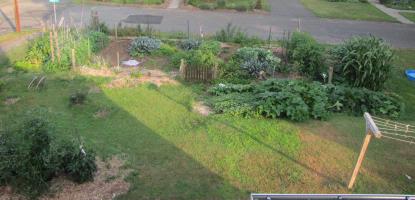
The garden today looks a little bare to me, but when I look back at a post from about a year ago it looked about the same.I’ve harvested onions and garlic and some f the fall crops are still coming in. I won’t despair yet.
Off to the far right of the picture above you can see some corn plants. They don’t look so big, so I took a close up shot with the indigent boarders. The one in blue shorts is six feet tall, so these corn plants are pretty big.
Of course that’s not true, he’s pretty short, but the cat toy he is holding has two inch round angry bird heads on it, so you should be able to estimate the corn’s size from that.
As I’ve mentioned before, I’m performing a minor experiment in the corn patch. I’m using two of the famed “three-sisters.” In this case I’ve got butternut squash growing under the corn. It’s spreading like mad and I may have to try this again. I’ve never quite understood the “three sisters” idea. Corn, beans and squash plants aren’t sisters. One is a monocot and certainly isnt’ closely related to the other two. Plus they’re not female. One has perfect flowers (with both naughty bits) and the others have both male and female flowers. That doesn’t sound like any sisters I know.
The squash keeps the weed pressure down, but doesn’t prevent the main scourge of corn for your non-pesticide reliant farmer: corn worms.
Strictly speaking these aren’t worms. Actually “worm” isn’t really a very strict biological term anyway as a whole slew of non-arthropod, non-legged, cylindrical beasts are described this way. Everything from microscopic nematodes to ocean creepies and parasites fall under the category. In common parlance even caterpillars are called worms. These are the worms I’m talking about here.
Corn is great at turning carbon dioxide and sunlight into sugar. Like some other plants that evolved around the fat waist of the planet, they are what’s called a C4 plant. C4 plants use a different sugar molecule when harvesting CO2 from the air. To do this they require huge amounts of nitrogen for enzymes.
All of this results in a plant that is difficult to resist as a food source. Various moths deposit eggs on corn plants and their larva (i.e. caterpillars) feed on the plant voraciously. The image below shows a hole created by one of these monsters, possibly the European Corn Borer.
There are pesticides to kill the worms, but I generally avoid traditional pesticides so I’ve only got one option Bacillus Thuringiensis or Bt. This can be applied to the silks right after pollination (before they turn brown). It can also be placed where the silks enter the ear. To get rid of the stem borers it can be sprayed on the plant. Bt is a bacterium that makes a protein toxic to caterpillars. More on this next time.
For now though, I cut the dying corn plant out and gave it to the ladies. If there’s a worm in there, they’ll find it.


